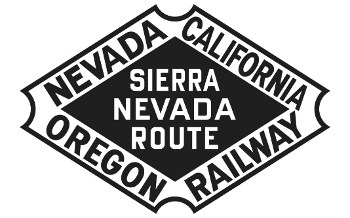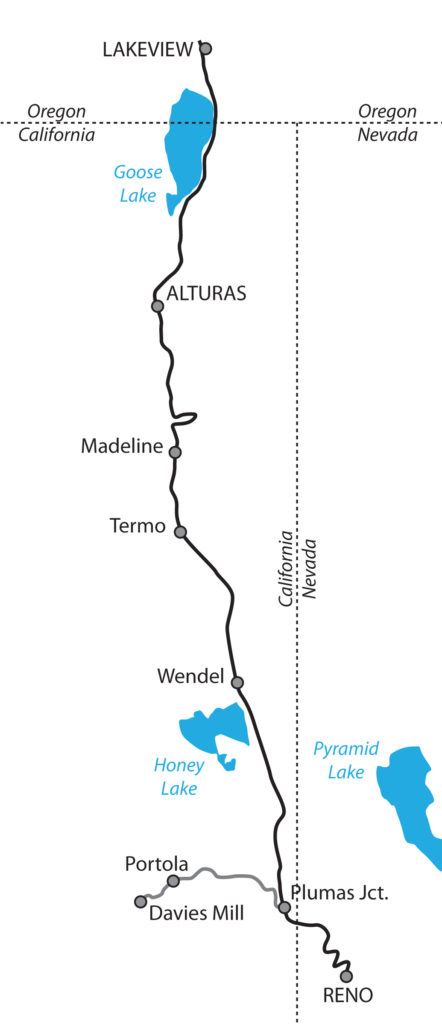A Brief History of the Nevada – California – Oregon Railway
In December 1879, a group of investors led by John T. Davis formed the Western Nevada Railroad Company to build south from Wadsworth, Nevada to the Walker Lake region. As additional investors became involved, the focus shifted to Reno, Nevada and a proposed railroad from Bodie, California, north through Reno to the Columbia River became the focus. The company re-incorporated as the Nevada & Oregon Railroad. These early days of the N&O were filled with corporate intrigue and shenanigans, including one Board of Directors meeting ending in a gunfight between opposing factions and a period of time when two separate Boards claimed direction of the company.
The first ground was broken in Reno on December 22, 1880, however corporate dysfunction and a lack of funds kept construction at a slow pace. The company decided to focus on the line north from Reno. “Narrow Gauge Fever” was sweeping the country at this time. The argument that narrow gauge meant cheaper construction costs was enough to convince the N&O to build its tracks at three feet between the rails. This compares to the four foot, eight and a half inches between standard gauge rails.
Grading progressed slowly and the first rails were spiked down on May 28, 1881. By September 8, 1881, crews had completed 21 miles of grade and 10 miles of track. The completed railroad stretched to Oneida, CA, 30 miles north of Reno and between current day Hallelujah Junction and Bordertown, by September of 1882. The company commenced regular service between Reno and Oneida on October 2.
The Moran Brothers, a New York banking firm, had been one of the early and most prominent investors in the Nevada & Oregon. On April 17, 1884 the Morans purchased the company at a court ordered auction, taking full control of the railroad with a bid of $372,534.21. The railroad got a new name in January 1885: the Nevada & California Railroad. With relatively firm financial footing and constant leadership, northward construction once again picked up in October 1885.
The rails reached Plumas Junction, at the foot of Beckwourth Pass, by the end of 1884. A separate company, the Sierra Valley and Mohawk, was incorporated the next year to build a line west, but work stopped by 1887. On the N&C, construction resumed at that time, with tracks running along the eastern shores of Honey Lake. Bypassing the town of Susanville, CA led the citizens to became so disgusted with the narrow gauge that many merchants chose to team supplies to and from Chico instead of patronizing the more local line.
Rails finally reached the newly established town of Amedee in 1890, where construction stopped. The company spent the next several years trying to build up business and weathering various financial panics that made additional capital difficult to access. On January 1, 1893 the railroad received its final name: the Nevada-California-Oregon Railway. The initials “NCO” inspired at least two nicknames for the line, the “Narrow, Crooked & Ornery” and the “Northern California Outrage”.
On January 17, 1895, the SV&M was taken over by the Sierra Valley Railways and track pushed through Portola to Clairville. Construction on the N-C-O restarted in 1899, and by June 1900, 50 new miles of track had been spiked down. The year 1901 saw the railroad reach its new terminus of Madeline and acquire the connecting Sierra Valley Railways. Construction halted again until June 1906 when the next phase started and rails reached Alturas in December 1908. Construction pushed northward to Lakeview, Oregon, reaching their farthest extent on January 10, 1912. It had taken the company 32 years to build 238 miles of railroad from Reno to Lakeview.
The N-C-O charter listed plans to continue north through Prineville to The Dalles on the Columbia River, with one branch running through Klamath Falls to the Rogue River Valley and another running to the Eugene area in the Willamette Valley, but no further construction ever took place. In 1915, the Sierra Valley Railways (since renamed the Sierra and Mohawk) was dissolved and became the N-C-O’s Plumas Branch. It was extended a few miles west to Davies Mill (Graeagle) in 1916, thus becoming one of the longest narrow gauge railways in North America totaling 275 miles.
The N-C-O mainline survived as an intact railroad for only six years. In 1917, the railroad sold the 64 miles south of Hackstaff, CA, plus the Plumas Branch, to the Western Pacific Railroad for $700,000. WP abandoned all but two segments between Reno and Beckwourth Pass, converting them to standard gauge and adding new construction to create its Reno branch. The N-C-O left Reno for good on January 20, 1918, moving the company’s headquarters and shops to Alturas. By 1922, the railroad was in a critical financial situation, and the Morans were looking for a way out.
Relief came in 1925 when the Southern Pacific offered to purchase the company. The SP took control in October 1926 and converted the railroad to standard gauge between 1927 and 1928. At the same time, the SP began construction of a line from Klamath Falls to Alturas and connected its line from Fernley, NV to Westwood, CA to the N-C-O at Wendel, forming the famous “Modoc Line”. Much of the N-C-O’s equipment went south to the SP narrow gauge system in California’s Owens Valley or was sold to other operators. SP maintained the original N-C-O name on standard gauge equipment assigned to line until September 1, 1929.
The former N-C-O from Wendel to south of Alturas was abandoned by successor Union Pacific in 1996. Today, only the two segments that became part of the WP’s Reno Branch (now run by Union Pacific) and the line from Alturas to Lakeview survive from the original N-C-O. The Lakeview section is today operated by the Goose Lake Railway.

